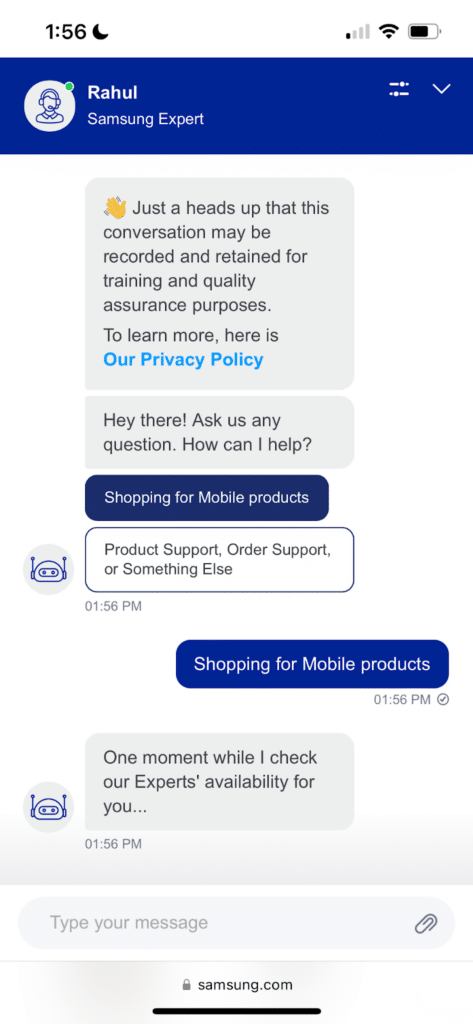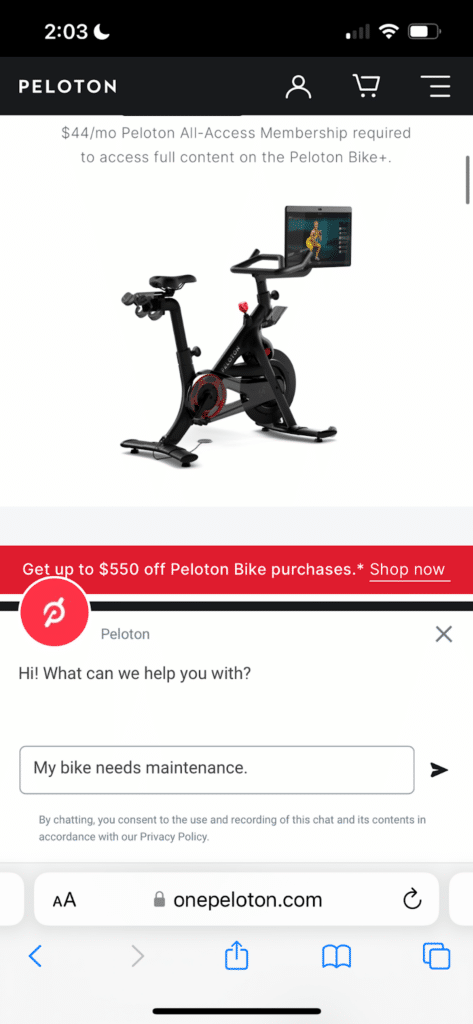The Connected Customer in Salesforce: A Guide for Retail CPG Brands

Consumer behavior and preferences are always changing. That’s nothing new. However, in the last few years, we’ve seen a rapid (and dramatic) shift in the way shoppers browse and buy consumer goods – and how they interact with the brands that make these products.
Today’s shoppers have endless information at their fingertips. While in-store shopping is still a viable option, a growing portion of consumer goods shoppers are browsing and buying via websites, mobile apps, social media, and messaging – among other channels.
Retail and consumer goods brands must be equipped to deliver outstanding, seamless experiences across consumers’ favorite channels. Otherwise, those shoppers won’t hesitate to walk away. Consider the fact that seven in 10 consumers have switched brands at least once in the past year.
Seven in 10 consumers have switched brands at least once in the past year.
Source: Salesforce State of the Connected Customer Fifth Edition
In this guide, we’ll zero in on some key trends we’re seeing in the world of retail consumer goods – and why brands must adapt to win customers and earn their loyalty.
Retail Consumer Goods Shoppers Have Lofty Expectations
Generally speaking, consumers’ expectations have never been higher. Those shopping for consumer goods are certainly no exception.
Consumers Expect Outstanding Experiences
Delivering outstanding products and services is still important. But increasingly, it’s experiences that drive consumer behavior. Per Salesforce, 80% of customers say the experience a brand provides is as important as its products or services.
80% of customers say the experience a company provides is as important as its products or services.
Source: Salesforce State of the Connected Customer Sixth Edition
And one-size-fits-all experiences won’t cut it. Rather, consumer goods shoppers demand personalized experiences – every single time. 65% expect brands to adapt to their changing needs and preferences. Yet, 61% feel most companies treat them as a number.
In addition, these shoppers expect speed – whenever and wherever a need might arise. More than three-quarters (77%) expect to interact with someone immediately when they contact a brand.
77% of customers expect to interact with someone immediately when they contact a company.
Source: Salesforce State of the Connected Customer Sixth Edition
Consumer Goods Brands Often Struggle to Meet Shoppers’ Expectations
Brands that are able to meet these lofty expectations can set themselves apart from the pack. But it’s no small feat. Balancing speed with quality can be downright tough. This is especially true for the many brands that are faced with flat (or even reduced) headcounts.
AI Holds Huge Potential for Consumer Goods Brands – But it Must be Used Thoughtfully
Today, a growing number of retail consumer goods brands are tapping into artificial intelligence to deliver engaging experiences at scale.
AI – once a topic discussed only among the most tech-savvy – has evolved rapidly and gone “mainstream.” Consumers have grown accustomed to AI in their daily lives, and many are open to its use when interacting with brands.
Per Salesforce, 56% of customers are open to the use of AI to improve their experiences. And 53% feel generative AI will help companies better serve their customers.
56% of customers are open to the use of AI to improve their experiences.
Source: Salesforce State of the Connected Customer Sixth Edition
AI holds huge potential. But while it’s tempting to go all in on AI, brands must proceed with caution.
Many consumers have concerns about the implications of AI related to ethics, bias, and security (among others). As such, brands must work to earn and cultivate shoppers’ trust. After all, 68% of customers feel advances in AI make it more important for brands to be trustworthy.
Transparency is foundational to trust. 57% of customers say greater visibility into the use of AI would deepen their trust in it.
In addition, brands must be sure to design thoughtful, positive AI-driven experiences for customers. A poorly executed initiative can send a customer packing. Case in point? 68% of customers wouldn’t use a company’s chatbot again after having a negative experience.
In the World of Retail Consumer Goods, Connected Experiences are Key
In the past, consumer goods shoppers made most of their purchases in a physical store. These days, that’s no longer the case.
Sure brick-and-mortar is still alive and well. But modern consumers have myriad ways to interact with brands and make purchases – from ecommerce sites and mobile apps to social media and messaging channels… and everything in between.
But shoppers aren’t choosing one channel and sticking to it. Instead, Salesforce research tells us the average consumer engages with companies across eight channels. And 71% prefer different channels depending on context.
The average consumer engages with companies across eight channels.
Source: Salesforce State of the Connected Customer Sixth Edition
Consumers Expect Connected Experiences Across All Channels
They want (and expect) those interactions to be seamless. They want the freedom to use one channel – then pick up where they left off on another.
Salesforce research found that 79% of customers expect consistent interactions across departments. And 70% expect every brand representative they interact with to have the same information about them.
Consumers Expect Connected Experiences
79% of customers expect consistent interactions across departments
Source: Salesforce State of the Connected Customer Sixth Edition
70% expect every brand representative they interact with to have the same information about them
More Often Than Not, Customer Experiences are Disjointed
But more often than not, brands fail to meet shoppers’ expectations for connected experiences. 56% of consumers often have to repeat or reexplain information to different representatives at a brand. And 55% typically feel like they’re communicating with separate departments, not one company.
In fact, according to Salesforce, consumers’ top frustration with organizations is disconnected experiences.
Your Ability to Deliver Connected Experiences is a Competitive Differentiator
Sure, these stats are disheartening. But they also point to a huge opportunity for brands that get it right.
Make it a top priority to deliver connected, seamless experiences. It’ll set your brand apart – which will enable you to attract more customers and grow revenue.
A single source of truth for your customers is foundational. For example, Salesforce can house all customer data and interactions within a single platform. This gives you a 360 degree view of each customer – which can then be used to fuel connected experiences.
Driving Connected Experiences Across All Retail consumer Goods Subcategories
The retail consumer goods sector is quite broad. It includes a whole host of subcategories ranging from grocery and automotive – to everything in between.
Sure, consumers shop for different types of products in different ways. However, they have high expectations for great experiences – whatever it is they’re buying. As such, all retail consumer goods brands, regardless of product or service offers, must make it a priority to consistently deliver personalized, connected customer experiences.
Let’s take a closer look at what this looks like for a handful of key consumer goods categories.
Connected Experiences for Home Improvement Brands
Home improvement purchases are highly personal. And often, it’s the brand that delivers the best experience that wins a customer’s business.
Shoppers do plenty of research prior to making a home improvement purchase. Brands must deliver connected experiences to streamline their product discovery. That way, shoppers can more easily find products that fit their unique needs and tastes.
Of course, great experiences shouldn’t end after the purchase. Often, a purchase of a home improvement product – such as flooring, landscaping or furniture – involves a home visit. Brands must equip their field services teams with the tools needed to deliver outstanding, connected experiences in the field.
Connected Experiences for Electronics Brands
When it comes to electronics, consumers have an overwhelming number of options. It can be challenging for them to sift through their choices to determine what will fit their needs.

The best electronics brands set themselves apart by delivering connected experiences throughout the purchase journey. Early on in the journey, these brands can deliver personalized recommendations based on a shopper’s purchase history, preferences, and feedback. In addition, service employees are equipped with the tools and data needed to deliver great post-sale service.
Connected Experiences for Fashion Brands
Consumers are serious about fashion. And increasingly, they’re browsing and buying these products via digital channels. Brands must deliver engaging, connected experiences that enable shoppers to find the perfect items for their needs.
Today, some of the best fashion brands are tapping into AI to deliver great shopping experiences – regardless of device. For example, some brands allow shoppers to virtually “try on” fashion items. Others may offer personalized style suggestions, based on purchase history, browsing history, as well as feedback from the shopper. These brands can also leverage AI to suggest items that complement those that are already in the shopper’s cart. If the brand has brick-and-mortar stores, the shoppers can purchase online – and then arrange pick up in store.
Connected Experiences for Sporting Goods Brands
Chances are, a consumer shopping for sporting goods will engage with a brand in a variety of ways before making a purchase. They may browse the brand’s ecommerce site – and then ask for recommendations via live chat. Later on, they may see a post on TikTok about an exercise bike that caught their eye, so they send a message to the brand via the platform. That customer may also decide to visit a brick-and-mortar store to see the bike in person.
That customer expects connected experiences every step of the way.
When the customer eventually purchases the bike via WhatsApp, they opt for white glove service. The brand must ensure their field service team has the information and tools to ensure a great in-home experience at delivery – and any time a maintenance visit is required.

Connected Experiences for Automotive Brands
Those shopping for a new vehicle don’t usually just drop into a dealership. Instead, they do plenty of research first. In fact, a growing number of consumers are navigating the entire purchase journey online.
Today, the best automotive brands leverage a blend of AI and the human touch to deliver connected experiences that win customers.
Early in the purchase journey, AI can deliver personalized recommendations based on the driver’s needs and preferences. This helps the driver narrow in on the products that’ll best suit them. Brands can also use AI to allow prospective customers to schedule an appointment at a dealership.

After the purchase, brands can leverage AI to help consumers learn more about their new vehicle – and schedule routine maintenance.
Connected Experiences for Grocery Brands
Traditionally, grocery lagged behind other consumer goods categories in terms of ecommerce growth. But in the early days of the pandemic, online grocery shopping exploded.
There’s plenty of opportunities for grocery brands to leverage AI to deliver better grocery shopping experiences. For example, grocery services can deliver tailored product recommendations, based on the shopper’s past purchases and the items they currently have in their carts. They can also use AI to allow shoppers to schedule, reschedule, or cancel pickup orders.
Bringing Back Small-Town Connections
We’re experiencing a big shift in the dynamics of retail. Ecommerce is growing. Traditional, small-town stores are being replaced by large enterprises. And customers are often interacting with AI.
Does this all mean the human connection is no longer necessary?
Absolutely not.
When Interacting With Brands, Consumers Still Value the Human Touch
Customers still place tremendous value on the human touch. In fact, nearly half of customers are willing to pay extra for better service. This number is even higher – three-fifths – among Millennials.
And while many consumers are open to the use of AI, they still want human involvement. Eight in ten (81%) consumers feel it’s important for a live human to validate the output of AI.
81% of consumers feel it’s important for a live human to validate the output of AI.
Source: Salesforce State of the Connected Customer Sixth Edition
Brands Must Equip Local Stores with Digital Tools to Connect With Shoppers
Often, large corporations are replacing mom and pop shops. Yet, consumers still want to make connections with actual humans. In many cases, a local employee is a consumer’s only interaction with an actual human from a brand.
As such, large enterprises can (and should) identify ways to bridge the gap to recreate those small-town, personalized connections.
For example, consumers increasingly prefer to engage with brands via digital channels – especially messaging channels. Brands must equip their local stores with the tools they need to effectively interact with customers via their preferred channels.
A solution like Messaging Studio from 1440 allows these local employees to engage with shoppers via messaging channels to provide personalized advice, recommendations, and assistance. In the future, those local store employees can reach out with information about new products and promotions that would interest the buyer – based on their unique needs and interests. And they can do it all right within the Salesforce mobile app.
With the right tools, your local employees can make lasting connections with local shoppers. These authentic connections will boost sales and foster loyalty.
Real Consumer Goods Brands Must Adapt to Meet Shoppers’ Expectations
Consumers have high expectations when shopping for retail consumer goods. They expect personalized experiences throughout the purchase journey. And they expect their experiences to be connected – regardless of the device and channel they’re using.
Retail consumer brands must adapt their strategies to meet shoppers’ expectations. If they don’t, customers won’t hesitate to leave.
AI can empower brands to deliver outstanding experiences at scale. However, trust and transparency must be at the forefront.
At the same time, human connections still matter.
The secret is to strike the right balance between AI and the human touch. By doing so, your brand will be well positioned to meet shoppers’ expectations throughout the purchase journey – while saving time and valuable resources.